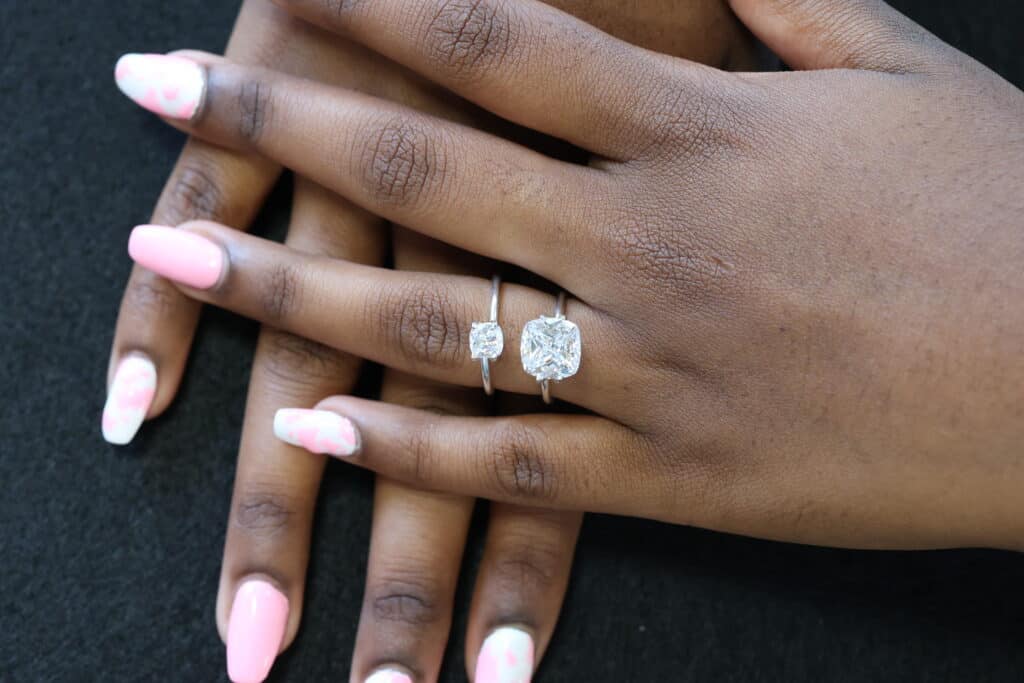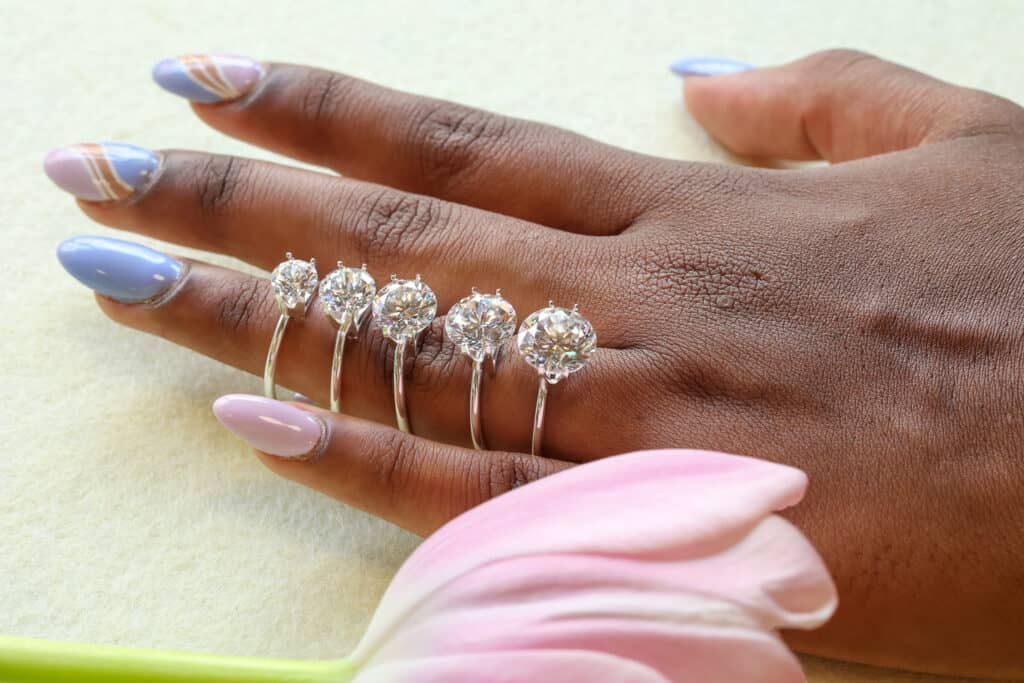With so many different options to choose from, selecting the right diamond shape for a ring or other jewelry can feel overwhelming.
As such, it comes as no surprise that many people switch from one preferred shape to another when shopping for a diamond — from princess to radiant, emerald to Asscher, or round to oval, pear or cushion cut.
This is a natural part of choosing the right type of diamond ring for your partner, and there’s no shame in changing your mind when it comes to diamond shape halfway through the process of finding and buying a diamond.
Recently, we were contacted by a reader asking for help buying a diamond engagement ring for an upcoming proposal. Here’s their original message:
“I have been working hard to save money with a plan to propose to my girlfriend by around August of this year (8 months from now) – I still have a good amount of saving to do, but when do you think I should begin to get really serious about my search for a ring?
A related question: once I’ve found the right diamond, how long will it take to get the ring made?
This will probably be the first of several questions from me, so thanks in advance for your advice!!”

This is a common question we get from readers. We let this reader know that it usually takes up to five days to finish the process of making the ring, but that it’s best to allow two to three weeks for the setting to be completed.
This reader also sent a second email with more information on the specific type of diamond they were interested in: at least 1.50 carat, round, cushion or radiant cut, with a yellow gold pavé ring or solitaire setting. Their total budget for the diamond and setting was $9,000.
This is very possible, especially when the tips in our full guide to buying a diamond are followed in order to avoid overspending on certain features of a diamond.
We suggested a 1.50 carat, H color, VS2 clarity cushion cut diamond to this reader — a diamond that matches their tastes and fits within their budget. At first, everything looked good, but as can often be the case, things ultimately went in a slightly different direction over time.
Switching From Cushion Cut to Round Cut
As we mentioned above, it’s very natural and normal to switch preferred diamond shapes as you start comparing diamonds closely. This is because some diamond shapes have distinct features that make them stand out and appear special, such as exceptional brilliance or reflections.
With this reader, we discussed what to look for in a cushion cut diamond and shared a variety of high-quality stones from James Allen and Blue Nile, the majority of which were in the 1.50 carat range.
This reader eventually settled on a stunning 1.51 carat, H color, SI1 clarity cushion cut diamond from James Allen, which was eye-clean and beautifully cut.
Job done, right? Not quite. Buying a diamond is a very personal decision, and it’s not just about finding a diamond that’s “technically” correct — for example, one that has the optimal level of cut quality, clarity and aesthetics — but also finding one that suits your partner’s tastes and style.

In this case, the reader ended up buying the beautiful cushion cut diamond they had selected on their own. Upon receiving it, they found it gorgeous, but ultimately came to the conclusion that a round cut diamond would be a better choice.
With certain diamond vendors, this could potentially be a problem. However, James Allen offers 100% free returns for unworn items purchased within 30 days, so this reader was able to return the diamond without any significant difficulties.
We suggested that they change from their first choice of cushion cut diamond to this 1.30 carat, H color, SI1 clarity round cut diamond.
You may notice that this diamond is slightly smaller than their original choice. This is largely due to the higher per-carat pricing for round diamonds compared to other shapes.
Round diamonds are cut through a process that involves removing a large portion of the original rough stone. This leaves around 40 percent of the original stone in the finished diamond. To put this in perspective, a princess cut diamond still contains about 80 percent of its initial weight.
Because of this, it’s usually necessary to downsize slightly when switching from any of the more affordable diamond shapes to the round brilliant cut.

Luckily, this small drop in carat weight is made up for by the fact that the round brilliant cut tends to appear larger than its physical weight due to its proportions, which emphasize the parts of the diamond that are visible once it’s set in an engagement ring.
This diamond also follows our “rules” for buying a round cut diamond: select a stone that has an eye-clean appearance (meaning no visible inclusions) and a color grade that allows it to appear colorless in its setting.
Because of the facet pattern of the round brilliant cut, you can find exceptional eye-clean stones in the SI1 to SI2 clarity range, eliminating any need to overspend for a clarity grade that has little or no impact on the diamond’s appearance.
An H color grade is also more than suitable for a diamond in this shape, as the exceptional light performance of the round brilliant cut means that there’s no need to pay extra for “perfect” color to avoid a diamond that appears tinted, even if you choose a white gold or platinum setting.
Thanks to its cut quality, clarity and color grade, this round cut diamond can look exceptional in any setting, from a simple solitaire engagement ring to a pavé or side-stone setting with smaller diamonds to complement its beauty.
Our Recommendation
It’s totally normal to change your mind when buying a diamond, sometimes several times. You may start out wanting a round brilliant cut diamond, only to change your mind when you see a princess cut diamond with exceptional brilliance and better value for money.
Alternatively, you might start the diamond buying process seeking out a unique shape, before switching to something versatile and timeless like a round brilliant cut diamond.
Opting for a round cut is the most common choice. As noted by the GIA, “it’s estimated that 75% of all diamonds sold are round-shaped.” In other words, the round cut is a safe choice that offers versatility, earning it a great deal of popularity from diamond buyers.
Luckily, online vendors like James Allen and Blue Nile make returning a diamond easy, letting you switch to a different shape (or to a different diamond of the same shape) if you feel like a certain diamond isn’t the right choice for you after it arrives.
There’s no objectively “best” diamond shape, meaning it’s essential to prioritize your personal tastes and preferences (or, more importantly, those of your partner) above anything else when you’re choosing an engagement ring.
Regardless of the specific diamond shape you choose, it’s important to pay careful attention to the diamond 4 Cs — cut quality, clarity, color and carat weight. These have the biggest impact on your choice of diamond’s beauty.
Select carefully and you’ll end up with a stunning diamond at a great price, whether it’s a round brilliant cut diamond or something eye-catching and unique like a heart-shaped diamond.
If you need any help with the process of comparing diamonds, or simply choosing a shape that matches your tastes, feel free to contact us.
We help hundreds of readers find and compare diamonds and engagement ring settings every month, and our team of experts is happy to help you track down your ideal engagement ring or other diamond jewelry.

- No questions asked returns within 30 days of shipment. James Allen will send you a paid shipping label to return the ring.
- Lifetime Warranty
- Free International Shipping
- Free prong tightening, repolishing, rhodium plating and cleaning every 6 months
- Provide insurance appraisals
- One free resizing within 60 days of purchase
- Free ring inscriptions
- Best-in-class high quality imagery of all diamonds in stock
- 24/7 Customer Service
- Best-in-class packaging


- No questions asked returns within 30 days of shipment. Blue Nile will send you a paid shipping label to return the ring.
- Lifetime Warranty
- Free Shipping
- Free prong tightening, repolishing, rhodium plating and cleaning every 6 months
- Provide insurance appraisal
- One free resizing within the first year of purchase
- High quality images of about half of their diamonds
- 24/7 Customer Service
- 100% credit towards future upgrades (must be at least double in value)
- Best in class fulfillment


